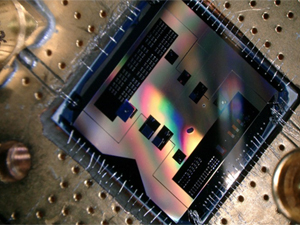



Date:12/03/19
 Weak radio signals are not just a challenge for people trying to find their favorite radio station, but also for magnetic resonance imaging (MRI) scanners at hospitals, as well as for the telescopes scientists use to peer into space.
Weak radio signals are not just a challenge for people trying to find their favorite radio station, but also for magnetic resonance imaging (MRI) scanners at hospitals, as well as for the telescopes scientists use to peer into space.
The usual answer for a weak radio signal is to locate a strong signal, for example, by picking an alternate radio station or by moving to the opposite side of the room. However, imagine a scenario in which we could simply listen more cautiously.
Now, scientists at the Delft University of Technology in Netherlands have found the answer to this. They have devised a quantum circuit to listen to the weakest radio signal allowed by quantum mechanics.
In a quantum leap in radio frequency detection, researchers in the group of Prof. Gary Steele in Delft demonstrated the detection of photons or quanta of energy, the weakest signals allowed by the theory of quantum mechanics.
Scientists believe that their solution could open the door to possible future applications in areas such as radio astronomy and medicine (MRI). It also enables experiments to shed light on the interplay between quantum mechanics and gravity.
Lead scientist Mario Gely explained, “One of the strange predictions of quantum mechanics is that energy comes in tiny little chunks called quanta. What does this mean? Say I am pushing a kid on a swing.”
“Quantum mechanics says something different: I can only increase the kid’s energy one ‘quantum step’ at a time. Pushing by half of that amount is not possible.”
“For a kid on a swing, these quantum steps are so tiny that they are too small to notice. Until recently, the same was true for radio waves.”
Scientists developed a quantum circuit that can actually detect these chunks of energy in radio frequency signals, opening up the potential for sensing radio waves at the quantum level.
Gely said, “Using our quantum radio, we want to try to listen to and control the quantum vibrations of heavy objects, and explore experimentally what happens when you mix quantum mechanics and gravity. Such experiments are hard, but if successful we would be able to test if we can make a quantum superposition of space-time itself, a new concept that would test our understanding of both quantum mechanics and general relativity.”
Scientists create quantum radio
 Weak radio signals are not just a challenge for people trying to find their favorite radio station, but also for magnetic resonance imaging (MRI) scanners at hospitals, as well as for the telescopes scientists use to peer into space.
Weak radio signals are not just a challenge for people trying to find their favorite radio station, but also for magnetic resonance imaging (MRI) scanners at hospitals, as well as for the telescopes scientists use to peer into space.The usual answer for a weak radio signal is to locate a strong signal, for example, by picking an alternate radio station or by moving to the opposite side of the room. However, imagine a scenario in which we could simply listen more cautiously.
Now, scientists at the Delft University of Technology in Netherlands have found the answer to this. They have devised a quantum circuit to listen to the weakest radio signal allowed by quantum mechanics.
In a quantum leap in radio frequency detection, researchers in the group of Prof. Gary Steele in Delft demonstrated the detection of photons or quanta of energy, the weakest signals allowed by the theory of quantum mechanics.
Scientists believe that their solution could open the door to possible future applications in areas such as radio astronomy and medicine (MRI). It also enables experiments to shed light on the interplay between quantum mechanics and gravity.
Lead scientist Mario Gely explained, “One of the strange predictions of quantum mechanics is that energy comes in tiny little chunks called quanta. What does this mean? Say I am pushing a kid on a swing.”
“Quantum mechanics says something different: I can only increase the kid’s energy one ‘quantum step’ at a time. Pushing by half of that amount is not possible.”
“For a kid on a swing, these quantum steps are so tiny that they are too small to notice. Until recently, the same was true for radio waves.”
Scientists developed a quantum circuit that can actually detect these chunks of energy in radio frequency signals, opening up the potential for sensing radio waves at the quantum level.
Gely said, “Using our quantum radio, we want to try to listen to and control the quantum vibrations of heavy objects, and explore experimentally what happens when you mix quantum mechanics and gravity. Such experiments are hard, but if successful we would be able to test if we can make a quantum superposition of space-time itself, a new concept that would test our understanding of both quantum mechanics and general relativity.”
Views: 410
©ictnews.az. All rights reserved.Similar news
- Azerbaijani project to monitor disease via mobile phones
- Innovative educational system to be improved under presidential decree
- NTRC prolongs license of two TV and radio organizations for 6 years
- Azerbaijan establishes e-registry for medicines
- Azerbaijani museum introduces e-guide
- Nar Mobile opens “Nar Dunyasi” sales and service center in Siyazan city
- International conference on custom electronic services held in Baku
- OIC secretary general to attend COMSTECH meeting in Baku
- Azerbaijan develops earthquake warning system
- New law to regulate transition to digital broadcasting in Azerbaijan
- Azerbaijani State Social Protection Fund introduces electronic digital signature
- Intellectual traffic management system in Baku to be commissioned in December
- Tax Ministry of Azerbaijan started receiving video-addresses
- World Bank recommends Azerbaijan to speed up e-service introduction in real estate
- Azerbaijan to shift to electronic registration of real estate





















